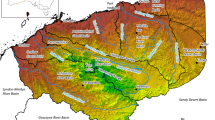Abstract
The Chalk aquifer of the English South Downs is very heavily utilised. The groundwater resources have enjoyed a formal programme of management which started in the 1950s, although a number of actions had been taken earlier in order to deal with saline intrusion and potential risk to groundwater quality from urbanisation. In the late 1950s the policy of ‘leakage/storage’ boreholes was first adopted, whereby the ‘leakage’ boreholes along the coast were pumped in winter to intercept fresh water discharge to the sea and to maximise the recharge potential inland, and inland ‘storage’ boreholes were used, as much as possible, in the summer months only. A comprehensive monitoring programme supported by aquifer modelling has enabled a gradual increase in overall abstraction to take place without increasing groundwater degradation due to saline intrusion. There have been various pollution prevention strategies over the years, and these have been effective in protecting the groundwater despite the high population density and widespread agricultural activity within the South Downs. The management of the aquifer has clearly been successful; there are many lessons from this experience that can be applied to other regions and other aquifers.
Similar content being viewed by others
References
Headworth, H. G. and Fox, G. B.: 1986, The South Downs Chalk aquifer: its development and management, J. Inst. Water Engineers Scientists 40, 345–361.
Headworth, H. G.: 1994, The groundwater schemes of Southern Water 1970–90, recollections of a golden age, Technical Report, Southern Water Group.
Jones H. K. and Robins N. S. <nt>(eds)</nt>: 1998, The South Downs Aquifer. National Groundwater Survey, Report British Geological Survey.
Miles, R.: 1993, Maintaining groundwater supplies during drought conditions in the Brighton area, J. Inst. Water Environ. Manage. 7, 382–386.
NRA: 1990, Groundwater Vulnerability Map of Sussex, 1: 100 000, National Rivers Authority, Worthing.
NRA: 1992, Policy and practice for the protection of groundwater, HMSO, London.
Nutbrown, D. A.: 1976, A model study of the effects of artificial recharge, J. Hydrology 31, 1–2, 57–65.
Price, M., Bird, M. J. and Foster, S. S. D.: 1976, Chalk pore size measurements and their significance, Water Services (October) 596–600.
Southern Water Authority: 1984, Aquifer protection policy, Southern Water Authority, Brighton.
Author information
Authors and Affiliations
Rights and permissions
About this article
Cite this article
Robins, N.S., Jones, H.K. & Ellis, J. An Aquifer Management Case Study – The Chalk of the English South Downs. Water Resources Management 13, 205–218 (1999). https://doi.org/10.1023/A:1008101727356
Issue Date:
DOI: https://doi.org/10.1023/A:1008101727356




